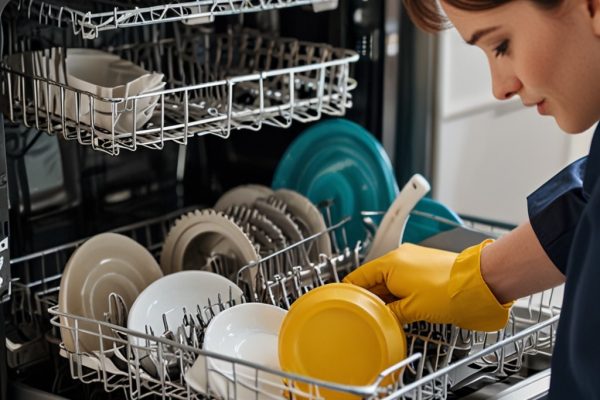Dishwashers have become indispensable appliances in modern kitchens, providing a convenient and efficient way to keep dishes clean. However, occasional problems may arise, affecting the dishwasher’s performance. Two common issues are salt build-up and problems with rinse aid, both of which can impact the cleanliness and longevity of your dishwasher. In this comprehensive guide, we will explore the causes, consequences, and solutions for salt build-up and rinse aid issues to help you maintain a smoothly functioning dishwasher.
Understanding the Role of Salt and Rinse Aid
Salt Build-Up:
Dishwashers use salt to soften water, preventing the accumulation of mineral deposits on dishes and internal components. Salt works in tandem with dishwasher detergent to ensure effective cleaning and prevent scale build-up, particularly in hard water areas.
Rinse Aid:
Rinse aid, on the other hand, aids in the drying process by reducing water droplets and promoting faster evaporation. It prevents the formation of water spots and streaks on glassware and dishes, contributing to a spotless and gleaming finish.
Common Signs of Salt Build-Up
– White residue on dishes: If you notice a chalky or white residue on your dishes, it may indicate insufficient salt in the dishwasher or a problem with the salt distribution system.
– Poor cleaning results: Salt build-up can compromise the efficiency of your dishwasher, leading to subpar cleaning results. Dishes may appear dirty or have spots and streaks even after a washing cycle.
– Salt container issues: If the salt container is not dispensing salt properly, it can lead to salt build-up. Inspect the container for any clogs or malfunctions.
Common Signs of Rinse Aid Problems
– Water spots and streaks: The primary purpose of rinse aid is to prevent water spots and streaks on dishes. If you notice persistent spotting despite using rinse aid, there may be an issue with its distribution or effectiveness.
– Wet dishes after the drying cycle: Rinse aid helps dishes dry quickly, so wet dishes at the end of the cycle could indicate a rinse aid problem. This issue may lead to longer drying times and a less-than-desirable finish.
– Empty rinse aid dispenser: If the rinse aid dispenser remains empty after multiple cycles, it suggests a problem with the dispensing system or the rinse aid container.
Causes of Salt Build-Up
Incorrect salt dosage: Ensure that you are using the correct type of dishwasher salt recommended for your appliance. Using the wrong type or incorrect dosage can contribute to salt build-up.
Salt container issues: Malfunctions in the salt container, such as clogs or dispenser problems, can lead to uneven salt distribution and subsequent build-up.
Water softener problems: If your dishwasher has a water softener, issues with its functioning can result in inadequate water softening and contribute to salt build-up.
Causes of Rinse Aid Problems
Incorrect rinse aid dosage: Similar to salt, using the correct type and dosage of rinse aid is crucial for optimal performance. Using too much or too little can lead to problems.
Rinse aid dispenser issues: Malfunctions in the dispenser, such as clogs or dispenser door problems, can hinder the proper distribution of rinse aid during the wash cycle.
Empty rinse aid container: Forgetting to refill the rinse aid container can result in ineffective drying and the appearance of water spots on dishes.
Solutions for Salt Build-Up
Check salt levels regularly: Monitor the salt levels in your dishwasher and refill the salt container as needed. Regular checks can prevent salt build-up and ensure optimal performance.
Use high-quality dishwasher salt: Choose a high-quality dishwasher salt specifically designed for your dishwasher model. Low-quality or generic salts may contain impurities that contribute to build-up.
Inspect the salt container: Regularly inspect the salt container for any blockages or dispenser issues. Clean the container and its components if necessary.
Run a cleaning cycle: Some dishwashers have a specific cleaning cycle. Run this cycle periodically to clean the internal components and prevent salt build-up.
Solutions for Rinse Aid Problems
Check rinse aid levels: Regularly check the rinse aid levels in the dispenser and refill it as needed. Adjust the rinse aid dosage settings based on your dishwasher’s recommendations.
Use the right rinse aid: Ensure you are using a rinse aid compatible with your dishwasher model. Consult your dishwasher’s manual for recommended products.
Clean the dispenser: Inspect the rinse aid dispenser for any clogs or obstructions. Clean the dispenser and its components to ensure proper dispensing during the wash cycle.
Run a cleaning cycle: Similar to addressing salt build-up, some dishwashers offer a cleaning cycle specifically for rinse aid-related issues. Run this cycle as recommended by the manufacturer.
Preventive Measures
Regular maintenance: Schedule regular maintenance checks for your dishwasher, including inspecting and cleaning the salt and rinse aid dispensers.
Use water softener additives: In areas with extremely hard water, consider using water softener additives in conjunction with dishwasher salt to enhance water softening and prevent mineral deposits.
Follow manufacturer guidelines: Adhere to the manufacturer’s guidelines for salt and rinse aid usage, dosage, and maintenance. This ensures optimal performance and extends the lifespan of your dishwasher.
Seek Professional Assistance
– If you encounter persistent issues with salt build-up or rinse aid problems despite following the troubleshooting steps, it’s advisable to seek professional assistance. A certified technician can diagnose and address complex issues, ensuring your dishwasher operates at its best.
Maintaining your dishwasher in top condition involves addressing common issues like salt build-up and rinse aid problems promptly. Regular checks, correct product usage, and adherence to manufacturer guidelines are key to preventing these issues and ensuring your dishwasher consistently delivers sparkling clean and dry dishes. By following the comprehensive guide provided, you can troubleshoot and resolve salt and rinse aid-related problems, contributing to the longevity and efficiency of your valuable kitchen appliance.
Our services are your reliable way to solve problems with household appliances! If your appliances require repair, don’t worry – contact Oceanside Appliance Service Center and we will help you forget about any inconvenience.
Our company has many years of experience in repairing household appliances of various brands and models. Our team of highly qualified technicians has deep knowledge and experience in working with refrigerators, washing machines, dryers, dishwashers, stoves, ovens and other devices.
We guarantee a professional approach to each task and the use of only original spare parts for repairs. Restoring your household appliances to optimal condition is our main goal.
Contact us


